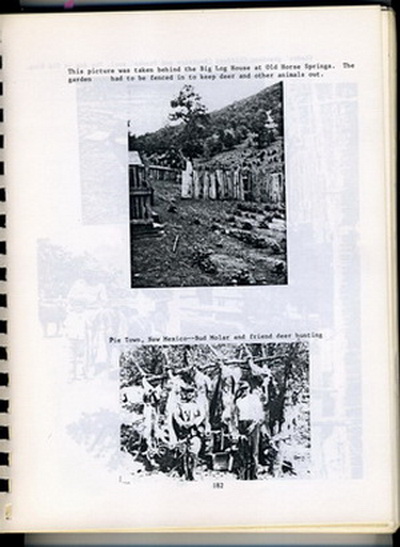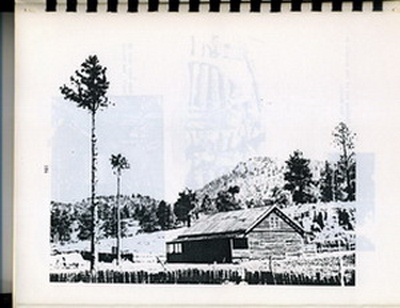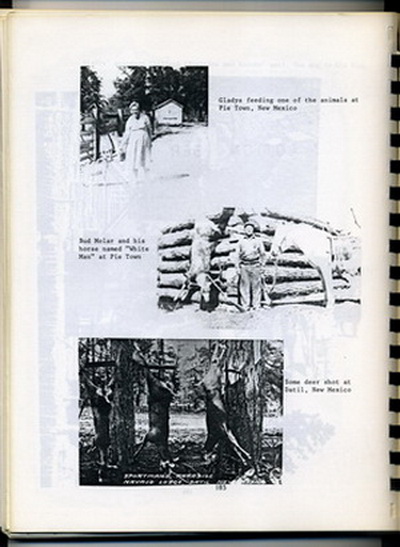Homesteader Stories
Gladys Louisa Waggoner
I married Lenord Harmon (Bud) Molar on June 17, 1919. Bud was a very big trader and was always on the go after something to feed his family. He did road work on county roads, hunted wild horses and he would break or train ox sell them. We came to Pie Town, New Mexico, with nothing to speak of—no worldly goods or money. Bud worked at cutting timber and clearing land, in saw mills, hunting, trapping and helping me build log fences. We built a log fence close to the half-dugout home. I had a garden inside the fence. Bud brought half wild white faced cows for milk for the family and to make cheese. He would insist on the calves having half of the milk. We raised wonderful gardens. We had large sweet cabbage, carrots, tomatoes and most anything else that had a short growing season. I made lots of cheese and cream cheese which I put away for trading in the fall. I traded this cheese to a little man who came to Pie Town. This little man brought apples and other fruit—some of which was dried. He also had pot and pans, needles and thread and other things that were so hard to get because it was so far to where you had to go to get them. He would take chickens, turkeys, pigs or cheese in trade. It was hard to buy feed for these animals, but they were a welcome change to our diet.
Most of our food was beef, deer, antelope, wild hog, turkey and squirrel. Bud knew people from all over the country—Silver City, New Mexico to Springerville, Arizona; north to Colorado to Socorro, New Mexico and Datil, New Mexico and Horse Springs, New Mexico. Horse Springs was a meeting place for so many who had homesteads and needed to trade or swap.
In Datil the big ranch house was the place to gather. It had a very big dining area with a large table. In the center of this large table was a lazy-susan.
This was quite an attract ion for people so far west. Most of these people had large hunting dogs that were used to hunt bear and other wild animals. Faye Edmonson Waggoner raised one of these dogs from a pup. She traded it to Otis Waggoner for a large hog that was ready to butcher. This was a very welcome change to what they had been eating and it would feed so many.
We didn't have money to buy barbed wire fencing, so we had to cut down trees and made a brush fence to hold our cows and horses. Bud was a good hunter and each year at deer season alot of hunters would come out to go with him. Elsie and I would go with them to do the cooking. Beatrice didn't like to go so she stayed at home to care for the stock. They always had cows to milk.
Bud ran a saw mill which we all worked at. We cut trees high upon the mountain and pulled them down in a draw with a team of horses. We loaded them on a wagon and hauled them to the mill. When Beatrice was 17 she married "Snooks" John R. Whinery. To this marriage two children were born; Robert Clifford and Danny Lester.
On one occasion, while living in the mountains, we lived in a half-dugout with dirt floors. Beatrice had a white straw hat that she wore to church which she kept under her bed. She wore it to church one Sunday and while she sat in her pew, she felt something crawling in her hair. She thought she had lice off the cows while milking. After church she pulled off her hat and a big black trantuala fell out.
The Navajos bought pinions from Bud. He would go to Gallop, New Mexico and bring the Indians back in the truck to pick the pinion nuts.
The Indians that had babys would carry them on their backs and the ones that were old enough to walk, walked beside their mothers or older families. They would cut the seat out of the childrens' britches so they wouldn't have to change them. The squaws sometimes wore four or five skirts at a time. When one got dirty, instead of taking it off and putting on a clean one, she would just put a clean one on top.
Beatrice used to have a turquoise ring they made for her. The Indians would make jewelry out of silver money. They would cut brush and build a brush circle about seven feet high and twelve to fifteen feet across. A fire was built in the center and they would sleep around the fire with their feet to the fire. Sometimes they would have what they called a dance by trotting around the circle while some chanted. Sometimes we would join them. It was fun! 'One time one of the Indians tried to trade his sister for Beatrice.
We didn't have creeks to fish in as there were few springs. If you drilled a well you would have to go 2,000 feet or more and then you may just get a dry hole. On our homestead, we didn't have water; neither did John and family. We had to hall water. We would load as many barrels in the wagon as we could—which was from six to eight (depending on how long the wagon bed was).
Bud traded our homestead for the land we built the big log house. It had a spring on it. We were so glad to not to have to haul water anymore. On our land we raised cows and horses. The Allegra and the Sawtooth Mountains were so steep we wouldn't go too high when we were out riding for fun and adventure.
Beatrice and Snooks' oldest son, Robert, works for the gas company in Hobbs, New Mexico. He married Shirley M. Davis of Hobbs. Their four children were Roberta, Robert Lake, Penny and Susie. They also raised and adopted one of their grandsons. The second son of Beatrice and Snooks is Danny Lester. He married Shirlie Kay of Hobbs. They had three children: Tammy, Alien and Elsie Mac. Elsie Mae was born at
She married Autry Mosley and they had one son .Elsie Mae and Autry divorced and she married Tommy Reighlant on at . They had children.
| From Top Left: 1) This picture was taken behind the Big Log House at Old Horse Springs 2) Pie Town New Mexico -- Bud Molar and friend deer hunting 3) no caption 4) Gladys feeding one of the animals at Pie Town, New Mexico 5) Bill Molar and his horse named "White Man" at Pie Town 6) Some deer shot at Datil, New Mexico |




